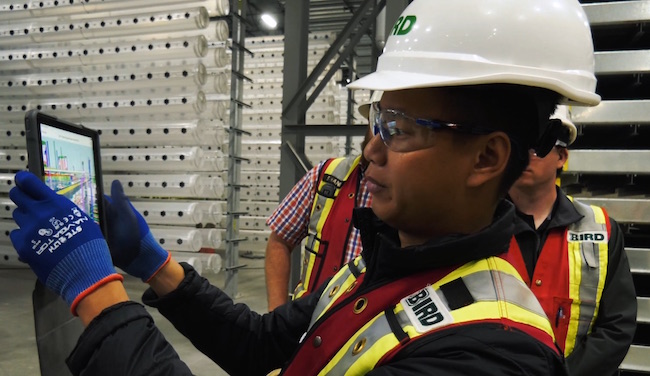

Construction is often criticized for being slow to the technology table. PHOTO: Getty Image/NicoElNino
One of the triumphs of networked computing is the enablement of global enterprises where knowledge, physical assets and human resources are managed cohesively across geographic and international boundaries. Today, the enterprise dashboard screen is as familiar to many as the boardroom table.
While such a vision has obvious advantages for contractors, the industry has been late to embrace the connected enterprise approach.
On one hand, there has been a widely acknowledged reluctance to embrace technology. “Construction is looked at as the last bastion of enterprise software,” says Paul McKeon, CEO and founder of Portsmouth, New Hampshire-based B2W Software. “It’s been historically a laggard in terms of embracing technology.”
On the other hand, construction has obvious challenges when it comes to connectivity. Not only is there geographic dispersion and a need to operate in remote areas where telco coverage is poor or nonexistent, but job site locations are in constant flux, making it impractical to put permanent IT infrastructure in place.
Efforts to mitigate these constraints are central to construction’s progress in the digital world. “If you create a tool that is going to connect the field to the office in construction, you can start unlocking some of those efficiencies that other industries have seen over the past 20 years,” says Jas Saraw, vice-president, Canada for Procore.
Many contractors are moving in this direction. “I’ve been at Kiewit for nine years, and it’s amazing how much has changed in terms of connectivity during that period,” says Brett Bock, director of Data Centre Operations at Kiewit in Omaha, Nebraska. “The modernization of the business processes is happening, and they’re doing that with technology. So to be connected to that application is becoming more and more important, and really a necessity.”
A key factor has been the adoption of Building Information Modelling (BIM) software, which is driving the digitization of design and planning processes and the accompanying expectation of more efficient work flows and faster iterations between job sites and the office.
“In this day and age, it’s extremely important that our project teams have access to all the latest project information, especially at the pace of change that we experience on our project sites,” says Mike Peters, manager of Operations Technology at Bird Construction in Winnipeg. “We no longer have time to wait to print out drawings and ship them to sites in order to act on changes and be able to complete work. So we need to ensure that we’re using digital work flows that enable our teams and our project partners to have an immediate single source of truth which ensures that we’re executing the work as designed.”
Teams may be geographically dispersed as well, creating a necessity for all members to be connected. “There are members of the project management team that may not be in a remote area full time,” Peters says, “but they can pull up the latest daily report and site photographs on their screen in real time. So it’s both getting information out to the project site and getting the information quickly back to the central office as well.”
BARRIERS TO CONNECTIVITY
The difficulty of getting service in remote areas has been greatly mitigated by improvements in wireless technology and software’s ability to take connectivity issues into account.
“In our business, we’re often working where there’s not a lot of telco infrastructure,” Bock says, “but today you can do a lot more with wireless. You could do a lot with 3G, but with 4G and 5G, there are job sites where that’s the sole way we connect that job site to the rest of the world. Before, wireless was a temporary solution until we got a permanent solution in place.”

Rapidly evolving technology has made it extremely important for crews to have the latest data at their fingertips. PHOTO: Bird Construction
There are limitations though, and not just in remote areas. “Bandwidth is always key, and not just the download bandwidth but upload as well — getting the information back to our central repository, or even just getting it up into the cloud,” says Peter Czezowski, manager of Technology Services at Bird Construction in Winnipeg. “It’s not just sites that are out there some- where in the wilderness that are an issue — [you] can have dead zones even within an urban area where there are not good connectivity options.”
Often the answer is to have a patch work of service providers. “We have to maintain relationships with multiple network providers, especially since we’re coast to coast,” Czezowski says. “Sometimes we have the best internet services available from a very small local carrier.”
The other piece is that apps, increasingly, are designed to work well offline. “If you’re in rural Alberta, we can’t guarantee that you’re going to have wifi connectivity at the job site,” Saraw says. “But that shouldn’t be an impediment to using mobile tech in the eld. Then uploading that data to the cloud once you receive wi-fi access — when you’re back in the trailer.”
Network management tools can also help by shaping traffic, Czezowski notes, thin client technologies like Citrix allow apps to communicate using less bandwidth. “We are presenting our apps via Citrix, and that helps,” he says. “However, you still need good bandwidth when somebody has to upload a document they’re trying to print to a local printer.”
ATTITUDES ABOUT TECHNOLOGY
Getting the enterprise digitally connected is a critical step, but there is no guarantee that the resulting work processes will be cohesive. To achieve that, people in the organization may have to change how they approach and utilize technology.
“Enterprise connectivity requires something that nobody wants to talk about, but that we really should be talking about as an industry, and that’s standardization,” says Rosemarie Lipman, chief innovation officer and senior vice-president of Digital and Data Engineering at Mississauga, Ont.-based EllisDon.
Putting a non-standard app on the corporate network is typically off limits in many sectors, but the practice is still wide- spread in construction. A common scenario is that a supervisor will have a particular problem on a job site — for example, keeping track of received materials — and find a great looking solution on an app store. The problem is, that solution may store all of the data in its own hosted cloud repository, making it unavailable to the rest of the enterprise.
“The market is completely saturated with startups and new technology from companies trying to solve these problems,” Peters says, “but you have to be intentional and work to solve your specific and maybe unique problems while ensuring applications have the ability to integrate with other tools that we have in place.”

Getting on-site crews to use technology as instructed is one of the challenges contractors face today. PHOTO: Adobe Stock/Guruxox
“There should be a corporate mandate to use tools correctly,” McKeon says. “Do you really want key work flows managed with outdated, siloed tools that make it hard to access the data? That’s not the way you want to run your company.”
Standardization isn’t just about retaining data, however — in order for a digitally-enabled process to produce the desired result, people need to use applications in similar ways so that the information flows from one project to the next.
“Job sites tend to choose technology based on what they need right now,” says Paula Dobrowolska, vice-president of Enterprise Tech Solutions at EllisDon,” but they’re not really thinking how to standardize across the enterprise so that all of our projects and all of our data can be used to inform any new projects during the design phase. You have to have the parameters in place in order to be able to use that information in the future.”
“We really want to push people to utilize things in a certain way,” Lipman says. “It’s not necessarily being the big brother pushing from the top down, but about mixing a little bit of that with standardization to ensure that everything flows and that we have a quality data set at the end of the day.”
Essentially, users need to follow a set of standards so the IT team can create and deliver high quality information services that bene t everybody in the corporation.
“The value proposition for them is that if they use a tool in a particular way, we are going to be able to visualize and analyze their data and give them that information that much faster,” Lipman says. “At the end of the day, quick and easy is not ‘what shiny tool can they use for the duration of this project?’ It’s ‘how can we deliver them the insights and the information that they need to perform their role?’”
The real work, therefore, is gaining a common understanding of the problems people face, and how better information can help them be more successful. “Technology is not the challenge,” Lipman says.
This article first appeared in the March 2020 edition of On-Site. You can read through the whole issue here.




